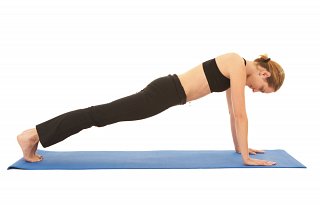Core Strength Training
Core Workouts and Strengthening Exercises.
What you should consider before you start

Core strength training is a term which has attracted a lot of media attention in recent years - and rightly so, as maintaining your core strength is a very important aspect to your overall health and fitness and helping prevent back, neck and shoulder pain.
However, the terms “core strength” and “abdominal strength” have come to mean the same thing in many core strength workouts that I have seen prescribed over the years. This is incorrect! Core exercises must target a lot more than just your stomach muscles!
Core Muscles - a quick guide
Your “core” consists of your abdominal muscles, back muscles and pelvic muscles. Furthermore, you have a deep core system which involves the small deep muscles of your spine and you have a superficial core system which involves your wider more superficial muscles.
Good core strength training requires you to become aware and understand these two muscle systems. Once you understand them you must then use them in conjunction with each other in a well-designed core strength programme that has been designed for your individual ability and needs.
Good Core strength exercise - the benefits
When your core muscle system is trained and working correctly it will stabilize your spine, pelvis and shoulder girdle areas and provide a solid base of support, not only for your spine but also for your movement patterns. Put simply, our body parts were designed to be in specific positions and to move in very specific ways.
Following an exercise program to develop your core strength - you will both stand and move more efficiently. You will feel fitter, taller and stronger and you will help the long term management and prevention of back, neck and shoulder problems.
Core Strength Exercises for back pain
Posture and core strength training has now become one of the pillars of my own physiotherapy practice. My interest started in this area many years ago when I noticed that my clients were getting great results most of the time - but some were returning with the same back and neck problems again 1-2 years later!

Why? - I asked myself!
The answer was that their underlying posture and core strength was the cause of their pain and that the exercises they were doing weren’t correcting that. In response, we had to tailor specific core strength and postural training classes to help them strengthen the muscles to further support the spine and improve their posture and movement patterns. Thankfully, this has proven to be successful and now weekly Pilates, Core Strengthening and Active Posture classes are now an integral part of my practice and back pain management programs.
Core Strength Exercises - where they don’t work
On the other hand, I would alert you to the fact that core strength training - when taught incorrectly - can compound a back pain problem and do more harm than good. Too often I see clients who have been doing self taught and gym taught core strength exercises without considering their predisposition to back pain problems.
Why is this? Well it is essentially down to a situation where your pain is being caused by poor postural habits and movement dysfunction, and the core exercises that you are doing reinforce that dysfunction.
Your core strengthening programme must be specific to you and your pain. A good instructor or course will insist on doing a preliminary one-on-one session or assessment, where they can assess your postural habits, movement patterns and core strength. This will enable them to understand what posture type you are and tailor specific exercises that work best for you - both in strengthening your core and correcting any bad postural or movement habits.
What to consider before you start.
An efficient core muscle system will help prevent injury, balance your energy, and reduce pain and tiredness in your body. A strong core distributes the pressure of any weight bearing exercises and thus protects your back. However, core strength training exercises need to target all the core muscles and to target them correctly!
-
If you have back pain and are looking for Core Strengthening Exercises to alleviate back pain, don’t simply download some exercises of the internet and follow them. You need more help than that! I would advise that you seek a chartered Physiotherapist or Physical Therapist who is qualified and experienced in injury rehabilitation exercise to assess you and prescribe specific core strength exercises that work best for you.
Ask them what courses they have done and don’t settle for someone with a qualification from a weekend course to be adequate for the back pain management of your health!
- If you are healthy, and well, with no back pain or movement problems - a qualified fitness instructor will be adequate for your needs once they are also well-trained in core workouts.
Once you have worked correctly on your core strength - you will both stand and move more efficiently. You will feel taller and stronger and you will help the long term management and prevention of back pain.
What are you waiting for!!
DISCLAIMER
While the content and materials contained in the articles on this website have been written & researched by Sally Ann Quirke, a professional, practising & fully qualified Chartered Physiotherapist (Physical Therapist) based in Ireland, they are provided for general information and educational purposes only. They do not constitute medical advice on any particular individual situation. Please see your Chartered Physiotherapist or other medical practitioner for full and individual consultation.
Please read the full disclaimer here.
Cookies and Privacy
By using this website, you consent to the use of cookies in accordance with our cookie policy. For more information on how we use cookies, please read our cookie policy here.
